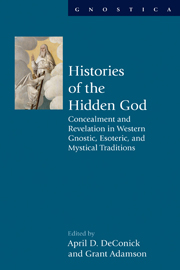 Histories of the Hidden God
Histories of the Hidden God from Part III - Revelations of the Hidden God
Monsters are in the world but not of the world. They are paradoxical personifications of otherness within sameness. That is, they are threatening figures of anomaly within the well-established and accepted order of things. They represent the outside that has gotten inside, the beyond-the-pale that, much to our horror, has gotten into the pale.
Timothy K. Beal, Religion and Its MonstersWhat is a monster? A being whose duration is incompatible with the existing order.
Diderot, Elements of PhysiologyHoustonians, myself included, are very proud of the fact that Houston was the first word spoken on the surface of the moon, by Apollo 11 astronaut Neil Armstrong, on July 20, 1969, to be precise: “Houston, Tranquility Base here, the Eagle has landed.” NASA is just down the road from where I sit and write, in Clear Lake. Our professional baseball team is called the Astros, our basketball team the Rockets. In the present essay, I would like to extend this local space culture (“the outside that has gotten inside”) and explore a few of the very extensive ways that pulp fiction, science fiction, and the cold war space race have entered modern occultism and a contemporary living mythology that I have been tracing through a two-volume study of the paranormal and American popular culture. More specifically, I would like to dwell here on a writer that I could only summarize there, the American journalist, UFO specialist, monster hunter, and self-described demonologist John A. Keel.
To save this book to your Kindle, first ensure [email protected] is added to your Approved Personal Document E-mail List under your Personal Document Settings on the Manage Your Content and Devices page of your Amazon account. Then enter the ‘name’ part of your Kindle email address below. Find out more about saving to your Kindle.
Note you can select to save to either the @free.kindle.com or @kindle.com variations. ‘@free.kindle.com’ emails are free but can only be saved to your device when it is connected to wi-fi. ‘@kindle.com’ emails can be delivered even when you are not connected to wi-fi, but note that service fees apply.
Find out more about the Kindle Personal Document Service.
To save content items to your account, please confirm that you agree to abide by our usage policies. If this is the first time you use this feature, you will be asked to authorise Cambridge Core to connect with your account. Find out more about saving content to Dropbox.
To save content items to your account, please confirm that you agree to abide by our usage policies. If this is the first time you use this feature, you will be asked to authorise Cambridge Core to connect with your account. Find out more about saving content to Google Drive.